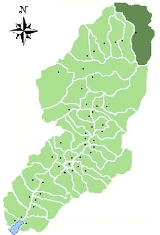
Ponte di Legno
Encyclopedia
Ponte di Legno is an Italian
comune
of 1816 inhabitants in Val Camonica
, province of Brescia
, in Lombardy
.
On September 27, 1917 was bombarded by cannons Austrians and razed to the ground in a short time.
Italy
Italy , officially the Italian Republic languages]] under the European Charter for Regional or Minority Languages. In each of these, Italy's official name is as follows:;;;;;;;;), is a unitary parliamentary republic in South-Central Europe. To the north it borders France, Switzerland, Austria and...
comune
Comune
In Italy, the comune is the basic administrative division, and may be properly approximated in casual speech by the English word township or municipality.-Importance and function:...
of 1816 inhabitants in Val Camonica
Val Camonica
Val Camonica is one of the largest valleys of the central Alps, in eastern Lombardy, about 90 km long. It starts from the Tonale Pass, at 1883 metres above sea level and ends at Corna Trentapassi, in the comune of Pisogne, near Lake Iseo...
, province of Brescia
Province of Brescia
The Province of Brescia is a Province in Lombardy, Italy. It borders with the province of Sondrio in the N and NW, the province of Bergamo in the W, province of Cremona in the SW and S, the province of Mantova to the S, and to the east, the province of Verona and Trentino .Source for statistical...
, in Lombardy
Lombardy
Lombardy is one of the 20 regions of Italy. The capital is Milan. One-sixth of Italy's population lives in Lombardy and about one fifth of Italy's GDP is produced in this region, making it the most populous and richest region in the country and one of the richest in the whole of Europe...
.
History
The territory of the municipality of Ponte di Legno was part of the ancient Dalaunia (Dalegno), which included also the comune of Temù.On September 27, 1917 was bombarded by cannons Austrians and razed to the ground in a short time.
Monuments and places of interest)
Religious architectures
The churches of Ponte di Legno are:- Parish of the Holy Trinity, dated 1685, though the wooden door is 1929.Inside there are works from the workshop of Ramus.
- Church St. Appollonio in Plampezzo. It is an ancient church dating from the twelfth century, with frescoes of the thirteenth century of the hand of the painter Johannes from Volpino.
Traditions and folklore
The scütüm are in camunian dialect nicknames, sometimes personal, elsewhere showing the characteristic features of a community. The one which characterize the people of the comune are:- Poia: Bòrse
- Zoanno: Gòs
- Pezzo: Benui
- Precasaglio: Berlif

